3rd place
Ben Tillman DESIGN
Ben Tillman - New Leaf
This is a housing complex focused around nurturing a sense of independence and community for each resident by providing a variety of opportunities for personal growth and social connection while also helping to shoulder key emotional and financial burdens that would otherwise hold them back.
Read moreHousing should reflect the needs and desires of the residents, accommodating their current status while facilitating them on their journey to reach their full potential. This design responds by creating spaces that feel both intimate and expansive, protected and exposed. It’s in these moments that residents can thrive independently with the strong support of their surrounding community. The housing forms highlight a beautiful and graceful imbalance as a broken piece of hard shell allows light, color and growth in. The gap in the lower level becomes key for occupants, as it provides ease of social connections for residents that may need it most, such as young parents or elderly residents.
A series of integrated gardens act as a multifaceted resource, reducing grocery costs and improving dietary independence. They allow for the therapeutic benefits of hands-on work, nurturing living things, physical activity and a collaborative experience, as the vertical gardens, medium planters and large agricultural plots providing diverse social opportunities.
The structure at the east end contains a wide range of tenant services configured to help reduce a variety of financial and emotional pressures. A dedicated support staff on the lower floor increases security, while also being on hand to respond to any tenant needs. Childcare services and tutoring spaces support education while providing a safe social space after school, reducing the emotional and fiscal pressure of finding care and allowing parents to put more energy towards pursuing their own opportunities. Finally, a dedicated social space on the top floor provides space for large gatherings and impromptu activities, especially during the cold months.
The emphasis on education extends to adults as well. A variety of sustainable life skills and job training classes are provided in the small corner building to both residents and the surrounding community, allowing them to learn together and form new bonds.
The design of the housing units supports the residents as well, as it revolves around a series of passive sustainable systems, including rainwater collection, high thermal insulation and a focus on natural lighting and ventilation. These aspects help to radically reduce the utility costs while providing a healthier living environment for the residents.
The emphasis on mental wellbeing, social connections, urban agriculture, integrated family and tenant services, and highly efficient sustainable design, holistically provides a more stable emotional and financial base for the residents and the surrounding community.
The design maintains affordability and low operating costs in many key ways. The buildings employ simple geometric forms, modular systems and adherence to a grid to maximize structural efficiency and minimize material waste. Primarily using economical materials with long lifespans and little need for maintenance, reduces construction and lifetime costs. The use of pier foundations minimizes excavation and site work required and by raising the structures above the ground plane greatly reduces the risk of flood damage and pests. Focusing on passive sustainable strategies and high insulation values reduces the size and wear on mechanical systems, minimizing upfront and long-term costs.
For more information
on the winning designs, contact Helen Malani at
hmalani@nnwa.us
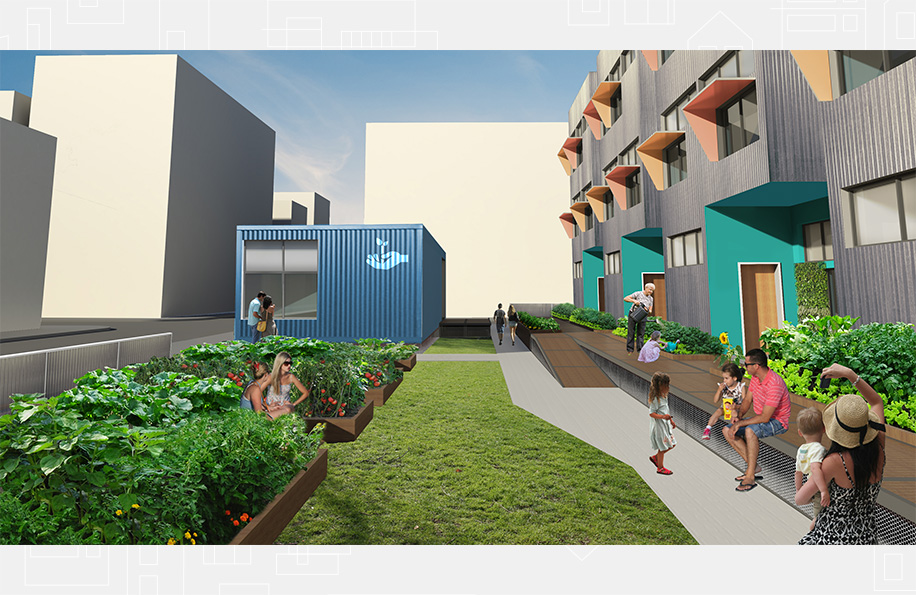
This design focuses on creating spaces that feel both intimate and expansive, protected and exposed. It’s in these moments that residents can thrive independently with the strong support of their surrounding community.
The porch in the lower level becomes key for occupants, as it provides ease of social connections for those that may need it most, such as young parents or elderly residents.
Raised walkways connect the units and create opportunities for impromptu seating, while also being used to gather rainwater for residential use and irrigation. The metal mesh panels along the sides provide easy access for maintenance while also adding visual interest.
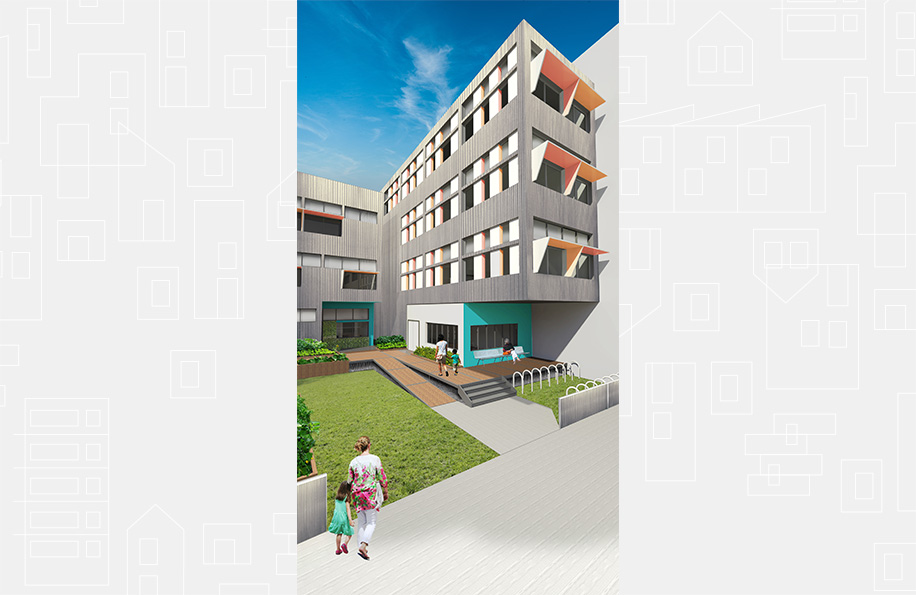
Childcare services and tutoring spaces support education while providing a safe, social space after school, reducing the emotional and fiscal pressure of finding care and allowing parents to put more energy towards pursuing their own opportunities.
A dedicated social space on the top floor provides space for large gatherings and impromptu activities, especially during the cold months.
The services building mimics the same design strategies as the housing units, while also using a series of narrow windows on the west facade to control the afternoon sunlight and allow visual connections to the courtyard below.
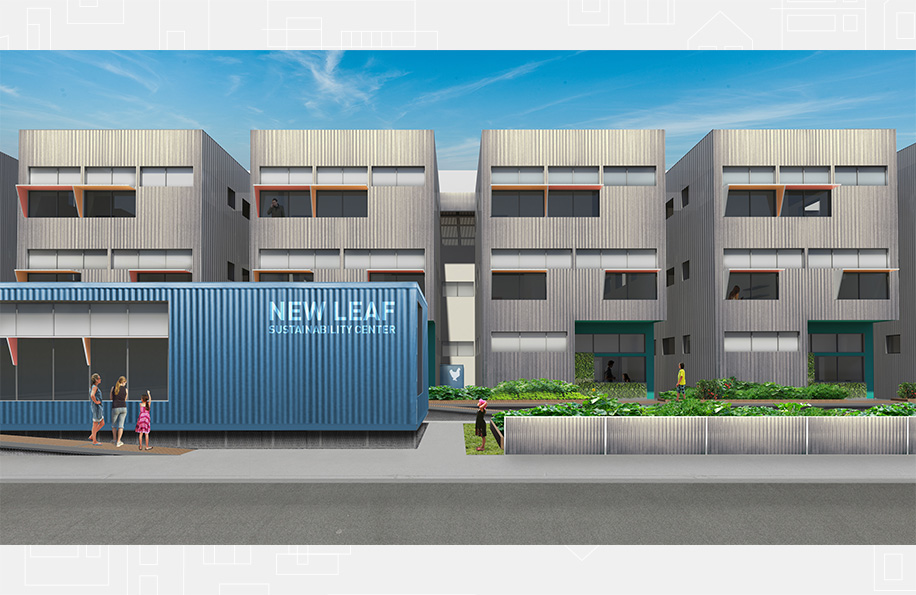
A variety of sustainable life skills and job training classes are provided in the small corner building to both residents and the surrounding community, allowing them to learn together and form new bonds.
Primarily using economical materials with long lifespans and little need for maintenance, reduces construction and lifetime costs.
A variety of garden types and sizes allows for growing different types of produce, reducing grocery costs and improving dietary independence. They also allow for the therapeutic benefits of hands-on work and physical activity, as well as collaboration and social interactions.
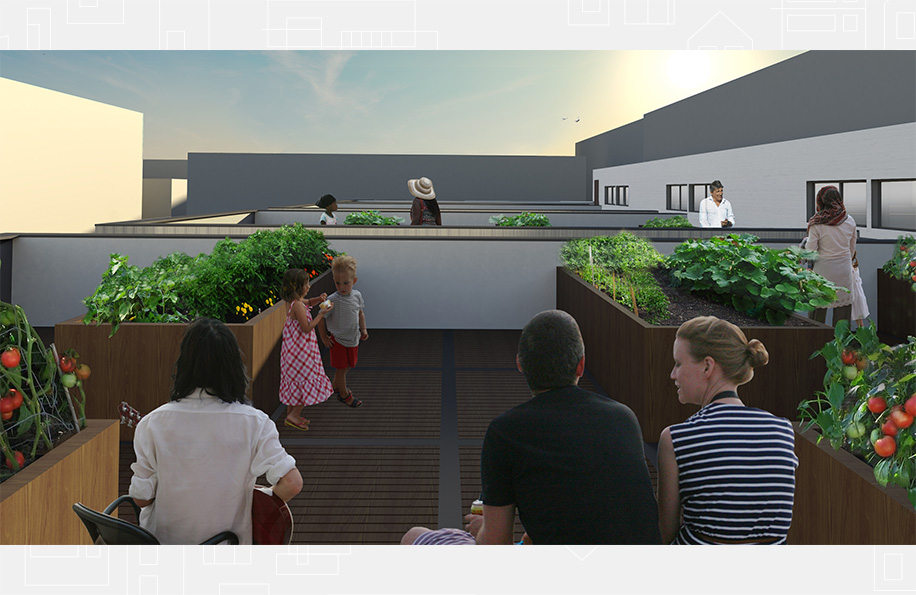
The top floor of every housing unit holds a segmented cluster of garden planters, which creates a series of intimate patio spaces for each of the residents, while also maintaining easy proximity to those around them.
The slatted walkway system gathers rainwater while also being inexpensive and easy to maintain.
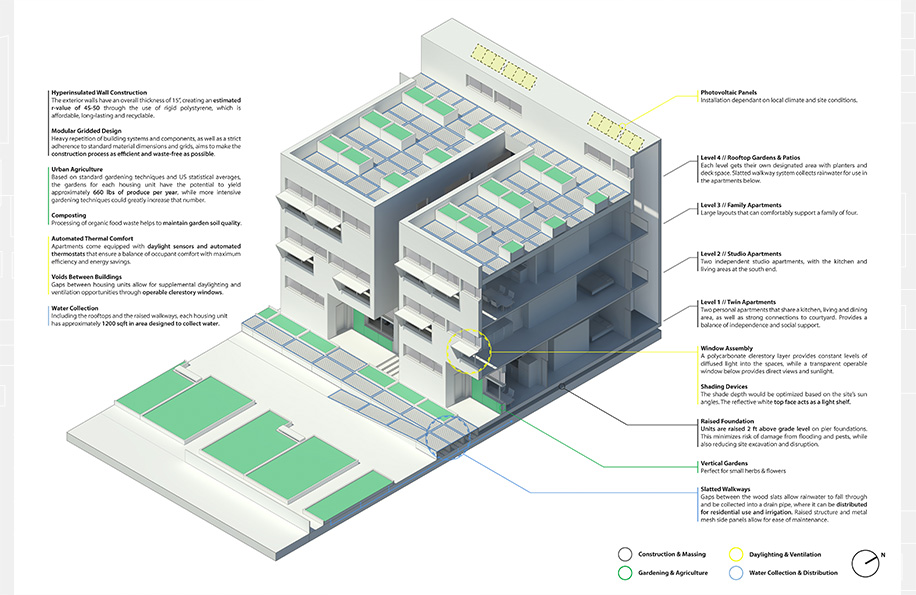
Utilizing a wide variety of passive sustainable systems and techniques, the housing units are designed to support the residents in terms of comfort and productivity,, as well as mental and physical wellbeing. Many of the systems also reduce the financial burden on the occupants by minimizing energy and resource consumption.
Focusing on passive sustainable strategies and high insulation values reduces the size and wear on mechanical systems, minimizing upfront and long-term costs.
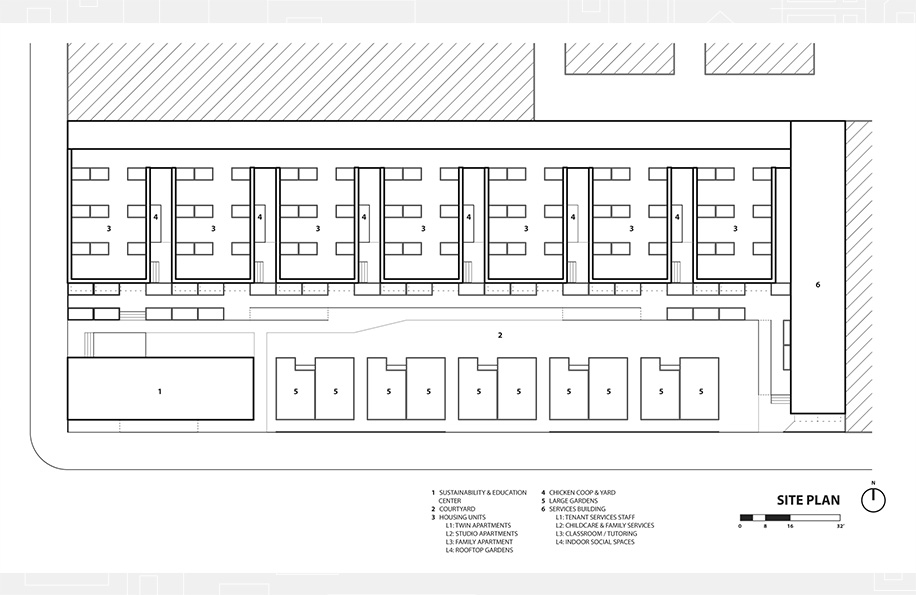
The housing mass along the north edge is sliced open periodically in order to draw supplemental daylight and natural ventilation into the spaces.
The education center in the southwest activates the corner and acts as a connection point between the residents and the surrounding community. It also maintains a low vertical profile in order to maximize daylight to the housing units behind it.
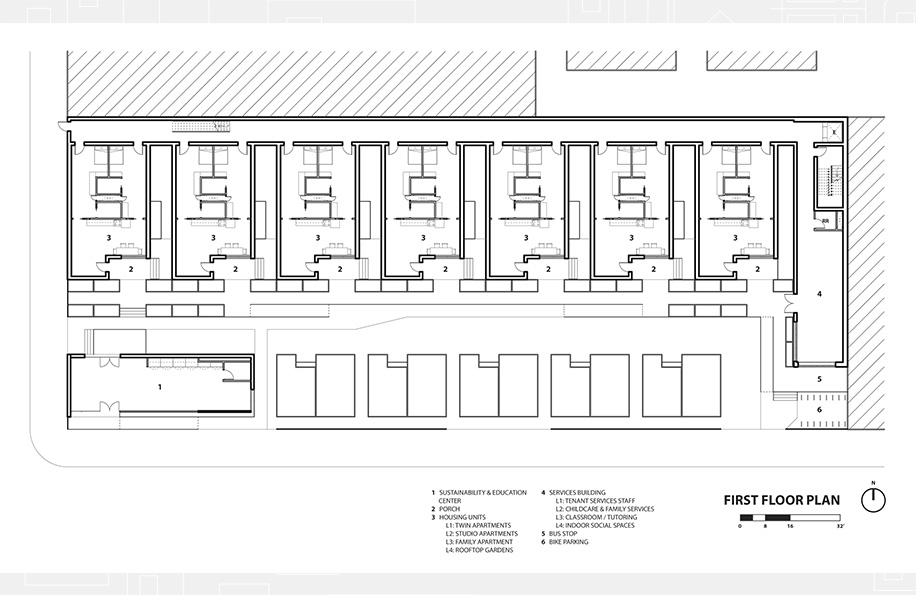
Using a different floor layout on each level, the housing units provide for a range of different resident types and lifestyles, allowing for movement within the community as life circumstances change and families grow. The layout shown is designed to provide support for residents who may benefit from community by sharing group spaces and responsibilities.
A secure corridor along the northern boundary of the site provides sheltered and monitored connections in the housing units.
Tenant services are housed in the base of the services building where they are able to maintain a high level of security and easy access for the residents.
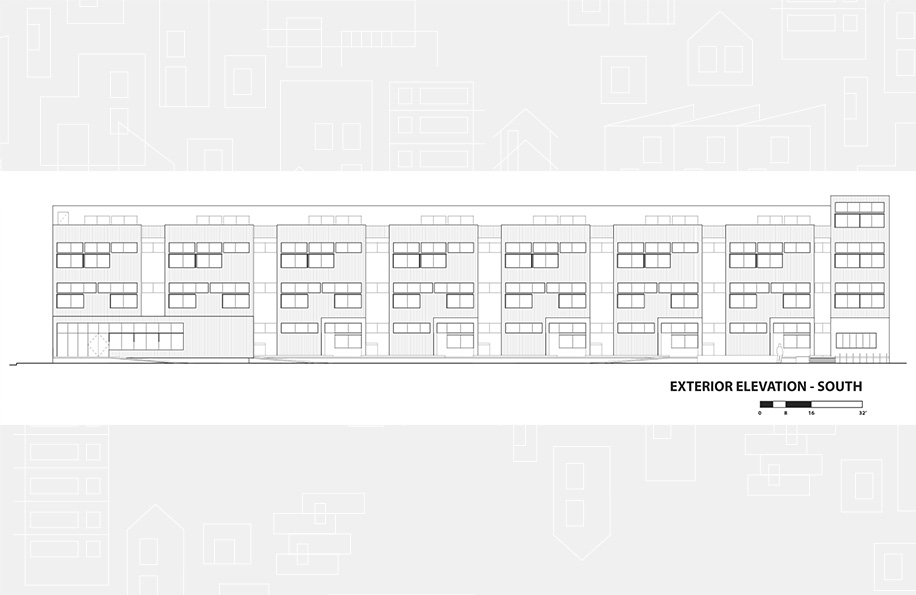
The exterior facade is primarily comprised of galvanized corrugated metal siding, which is durable, long lasting and easy to maintain.
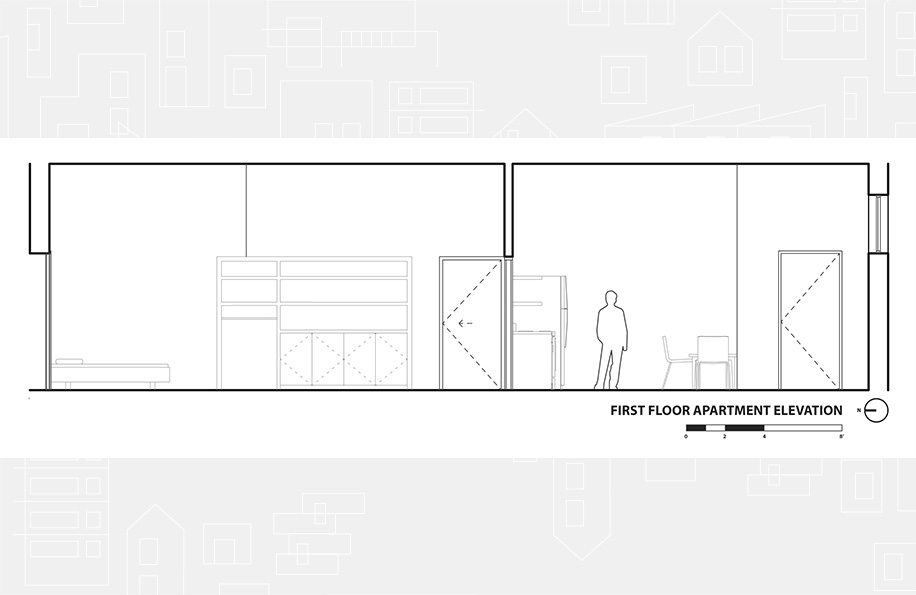
Shared living and dining spaces on the lower floor layout provide social and domestic support for residents who need it the most, such as young families and the elderly.
Polycarbonate clerestories provide ample natural lighting while retaining privacy and insulation from heat gain.









